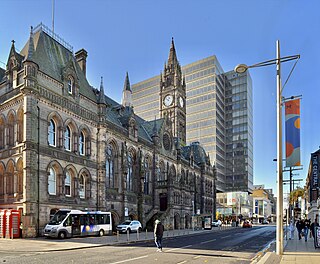
Middlesbrough, colloquially known as Boro, is a port town in North Yorkshire, England. Lying to the south of the River Tees, Middlesbrough forms part of the Teesside built-up area and the Tees Valley. It is located 41 miles (66 km) south of Newcastle upon Tyne, 43 miles (69 km) north of York, 66 miles (106 km) north-west of Leeds, and 217 miles (349 km) north of London. With a population of 148,215 recorded in 2021, Middlesbrough is one of the largest settlements in North East England.

The Royal London Hospital is a large teaching hospital in Whitechapel in the London Borough of Tower Hamlets. It is part of Barts Health NHS Trust. It provides district general hospital services for the City of London and Tower Hamlets and specialist tertiary care services for patients from across London and elsewhere. The current hospital building has 1248 beds and 34 wards. It opened in February 2012.

The Liverpool Royal Infirmary was a hospital in Pembroke Place in Liverpool, England. The building is now used by the University of Liverpool.

The Bristol Royal Infirmary, also known as the BRI, is a large teaching hospital in the centre of Bristol, England. It has links with the nearby University of Bristol and the Faculty of Health and Social Care at the University of the West of England, also in Bristol.

The James Cook University Hospital, formerly known as the South Cleveland Hospital, is a public tertiary referral hospital and regional major trauma centre in Middlesbrough, North Yorkshire, England with 1,046 beds. It forms part of the South Tees Hospitals NHS Foundation Trust, along with the Friarage Hospital in Northallerton. It is the second largest hospital in North East England by number of beds, after the Royal Victoria Infirmary in Newcastle upon Tyne.

City Hospital was a major hospital located in Birmingham, England, operated by the Sandwell and West Birmingham Hospitals NHS Trust. It provided an extensive range of general and specialist hospital services. It is located in the Winson Green area of the west of the city.

The Radcliffe Infirmary was a hospital in central north Oxford, England, located at the southern end of Woodstock Road on the western side, backing onto Walton Street.

Middlesex Hospital was a teaching hospital located in the Fitzrovia area of London, England. First opened as the Middlesex Infirmary in 1745 on Windmill Street, it was moved in 1757 to Mortimer Street where it remained until it was finally closed in 2005. Its staff and services were transferred to various sites within the University College London Hospitals NHS Trust. The Middlesex Hospital Medical School, with a history dating back to 1746, merged with the medical school of University College London in 1987.

Westminster Hospital was a hospital in London, England, founded in 1719. In 1834 a medical school attached to the hospital was formally founded. In 1939 a newly built hospital and medical school opened in Horseferry Road, Westminster. In 1994 the hospital closed, and its resources were moved to the new Chelsea and Westminster Hospital at the old St Stephen's Hospital site on Fulham Road.

Sir Bernhard Samuelson, 1st Baronet, was an industrialist, educationalist and a Liberal politician who sat in the House of Commons in 1859 and from 1865 to 1895.

St Leonard's Hospital is a hospital in Hoxton, London.

Liverpool Women's Hospital is a major obstetrics, gynaecology and neonatology research hospital in Liverpool, England. It is one of several specialist hospitals located within the Liverpool City Region, alongside Alder Hey Children's Hospital, Liverpool Heart and Chest Hospital, the Walton Centre, Mersey Regional Burns and Plastic Surgery Unit and Clatterbridge Cancer Centre. It is managed by the Liverpool Women's NHS Foundation Trust. The hospital receives approximately 50,000 patients annually and is the largest hospital for its specialism in Europe.
Robert Benny Lumsden TD, FRCSED was a Scottish consultant ear, nose and throat (E.N.T.) surgeon.

Violetta Thurstan, MM was an English nurse, author, weaver, and administrator whose work included help for refugees and prisoners of war. She knew several languages, travelled frequently and wrote a number of books. The first was about her experiences of nursing in dangerous troublespots during the First World War. She was honoured by three countries for her courage while nursing in the war, and was awarded the Military Medal.

Highgate Hospital was a name used to refer to the infirmary building which opened in 1869 on the St Pancras side of Dartmouth Park Hill in Highgate, London.

Middlesbrough started as a Benedictine priory on the south bank of the River Tees, its name possibly derived from it being midway between the holy sites of Durham and Whitby. The earliest recorded form of Middlesbrough's name is "Mydilsburgh", containing the term burgh.

The Gloucestershire Royal Infirmary was a hospital in Southgate Street, Gloucester.

The Borough of Middlesbrough is a unitary authority area with borough status in the ceremonial county of North Yorkshire, England, based around the town of Middlesbrough in the north of the county. Middlesbrough Council became a unitary authority in 1996. The borough is part of the Tees Valley Combined Authority, along with the boroughs of Stockton-on-Tees, Redcar and Cleveland, Hartlepool and Darlington. There are two parish councils in the area of the borough of Middlesbrough, Nunthorpe and Stainton and Thornton respectively.

Euphemia Steele Innes RRC DN was a Scottish nurse who served for 21 years as matron at Leeds General Infirmary in Leeds, West Riding of Yorkshire, England. She was decorated with the Royal Red Cross 1st class in 1916 for services with the Territorial Force Nursing Service in the First World War.
Eileen Mary Rees OBE FRCN was a British nurse and nurse educationalist.



















